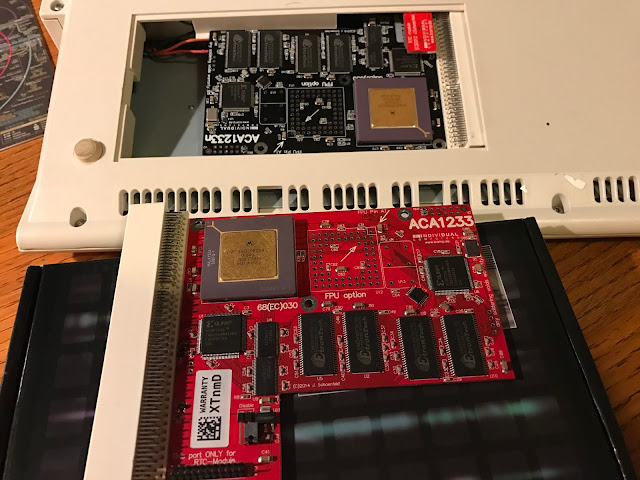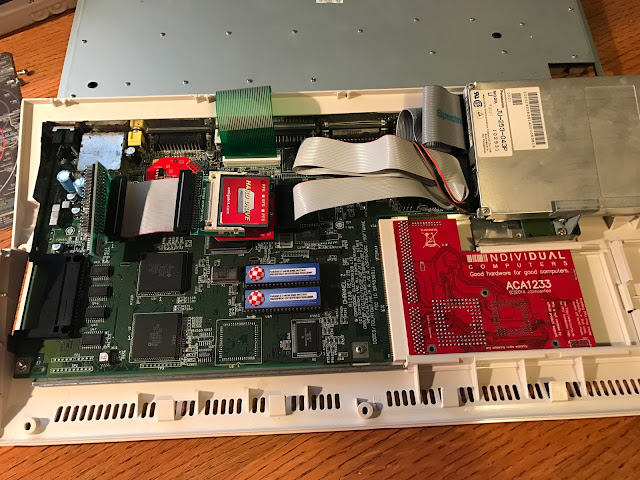What can I say - I did some serious shopping! I bought a lot of stuff from amigastore.eu and Individual Computers for projects on my Classic Amiga (not just the A1200) - more on those later on.
Today I focus on the A1200 projects. Here is the ACA1233-55 accelerator board, RTC (Real Time Clock battery) module for it, and TrueIDE for adding two CF cards to your Amiga 1200:
Some close up shots of the ACA1233-55. This board is only available directly from Individual Computers to my knowledge, which features an overclocked 68030 processor running at 55Mhz, with 128MB memory onboard.
It also has a clockport expansion port, which disappointedly is ONLY for the RTC module. Unlike the newer ACA1233n 030-25 which allows the Rapid Road to be connected to this port!
The decision not to update the 1233 while overclocking it safely to 55Mhz to include a Rapid Road compatible port baffles me for an expensive top level 030 card.
Anyway, here is the back of the board:
There is provision to solder on an FPU and associated crystal, but I lack to skills to do this so it will remain stock for now.
Here is the TrueIDE card from Individual Computers. As mentioned earlier it allows two CF cards to be installed.
What makes this different to the regular IDE to CF adapters is that it has circuitry in it to present the normally removable devices (under AmigaOS) to be fixed devices, allowing booting any OS from the cf cards. In addition a 3 second reset hold will boot the second cf card automatically, avoiding the need to select every time,
It also has two different mounting connections, allowing easy connection horizontally (in Amiga 1200/600, etc), or vertically in larger cases like the A4000D, and to Zorro card IDE adapters. It does require floppy power connection to the card though, and this presents a problem in an Amiga 1200 since there is only one floppy connector power cable connection available..I decided to shelve the TrueIDE for this part as I don't have a solution to that yet.
Moving on, here is the Rapid Road USB 2.0 clock port card:
Also included with the card is a floppy power connector for pass through on an Amiga 600/1200, clock port cable and USB 2.0 header cable with 2xUSB 2.0 ports on a Small form factor case expansion port mounting. There is also a floppy disk with the required Poseidon USB stack and Rapid Road USB drivers on it:
Interesting is that the whole board is covered in heat resistant solid perspex like material (I assume) to protect the unit from shorting inside the Amiga 1200/600 case. Nice thinking:
This card can be mounted on an Individual Computers A604n expansion on the A600, some ACA1233n accelerators, connected to an Individual Computers x-surf 100 card, or the clock port expansion directly on the A1200/600. There are options to connect it to other clock port expansions released for the Amiga over the years too:
Ok, so let's get these setup! First things first, the accelerator as it is the easiest to install. I flip over the Amiga 1200 case ready to pop out the expansion cover:
Here you can see the current ACA1233n with RTC module I installed in Part 1, alongside the brand new ACA1233-55 card:
Being lazy, I chose to put the RTC module from the 1233n card onto the A1233-55 card to avoid having to find another battery for the new RTC module I bought...here is the RTC module installed:
Here is the ACA1233-55 installed in the A1200 - it fits easily:
I hooked up the Amiga 1200 and booted up, all good so far - the extra 128MB memory is available.
Running SysInfo we can see the performance of the new A1233-55Mhz board - I understood the board runs at 55Mhz but SysInfo reckons it is 60.50Mhz! If so, then it is very nice improvement over the ACA1233n-25Mhz card I had in the A1200 before:
Here is the A1233n-25Mhz board SysInfo screenshot for comparison:
The card has 127MB + 1MB in reality. Anyway, here is 127MB Fast memory in SysInfo:
1MB slow memory is also included in the card, bringing it up to 128MB:
And here of course is the case 2.0MB CHIP that comes standard on the A1200:
Here I am enjoying Essence's Crazy Sexy Cool demo, which runs smoothly on the new 030 55Mhz accelerator:
Ok, having established the new accelerator works well, I moved on to installing the Rapid Road USB clock port expansion. This requires disassembling the A1200, so I got to work on that:
Closer view of the new accelerator installed in the now disassembled A1200:
Here is the Rapid Road, ready for installation:
Note that the printed instructions included with the Rapid Road are essentially useless. You need to go to the Wiki for Individual Computers for the real installation instructions, which includes the really important photos of how the device needs to be installed. Seriously, please include these in the printed instructions! The link to the instructions I used is here.
You can also download the ADF of the install disk - which I had to do too since the floppy disk I was given had a read error on it...I wrote our the ADF using Kryoflux on my MacBook Pro (could also use my X1000 or TransADF on a Classic Amiga) to a fresh floppy disk and then I was good to go.
The important thing when installing in a A1200 is the correct orientation of the clock port cable. If you get it the wrong way around you will destroy the Rapid Road.
There is two floppy power connectors on the Rapid Road. One goes to the power connector on the A1200 board. The other passes through to the A1200 floppy drive. That way power devices can be powered from the single power connector!
Closer view of the power pass through arrangement - I really like this feature.
I then routed the ground cable to the spare screw hole on the Amiga 1200 as per the instructions on the Wiki and screwed it in:
I then partially reassembled the Amiga 1200 to check things over:
As you can see the Rapid Road fits perfectly in the A1200:
Here is my (now fixed) installed floppy disk, ready to install the Rapid Road drivers and Poseidon.
I then powered on with a sense of worry about whether I put the Rapid Road clock port cable the right way around...helpfully it lights up white immediately to indicate it it correctly oriented, and all was good!
So I inserted the floppy disk on got on with the install.
As part of the install it installs Poseidon USB stack - note that this needs MUI 3.8+ installed, so if you don't have that installed, you need to install it first.
The new Rapid Road USB drivers are also installed:
I nominated to install the Poseidon software to run on startup. I then finished the installation, installed the fat95 program when prompted (needed for FAT32 drive support) and then rebooted.
Next I ran the Trident (Poseidon) Prefs in the Prefs drawer to configure it for using the new drivers - select the Controllers section and add the Rapid Road device using the rapidroadcpusb.device (the clock port version of the driver):
We are now connected and the USB 64GB flash drive I installed is picked up straight away.
One of the big features of Rapid Road is the support for USB 2.0 and the support to run removable hard disks (not just flash drives) without the need of a powered USB hub.
I tested this by connecting up my 1TB Western Digital USB drive, which I normally use with my MorphOS Powerbook, and contains all my Amiga system and data files for easy transfer to different machines. It fits nicely on top of the floppy drive as below:
The drive worked perfectly with the Rapid Road! This positioning of the drive has got me thinking to get a slimline USB hard disk that could sit there permanently...hmmmm...
Anyway, for now I decided to run my old demo group The Experience demos, which needs an 030-40 or better to run well:
This is a sad and nice moment for me, reminding me of my friend Mark (Axon), the coder of this demo "Terminal" back in 1998, who sadly passed away a little over a year ago now. Thanks for the great memories mate!
The demo ran perfectly on the new accelerator, running off the USB hard disk connected to the Rapid Road!
I still need to decide how to mount the USB ports since I have already used the expansion port at the rear for the DVI output from the Indivision AGA Mk2. Hmm, not sure yet. For now I decided to route the cable through a small gap in that port and under the floppy drive to the Rapid Road internally until I work out another way. Thoughts anyone?
Here is the Amiga 1200 all re-assembled again, with the USB ports running through the expansion port temporarily so I could close the case up.
I then connected a USB flash drive to the Rapid Road to make sure everything still works and it did - excellent!
Well, this seems like a good point to stop for now. That concludes Part 2 of the Amiga 1200 upgrade. There is more to do of course, and I will cover this in a future blog entry!
















































No comments:
Post a Comment
Note: only a member of this blog may post a comment.